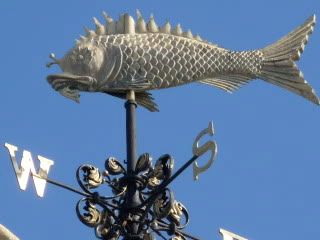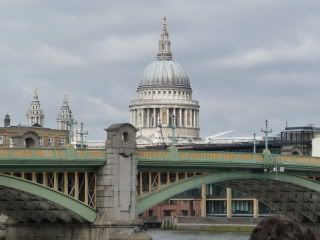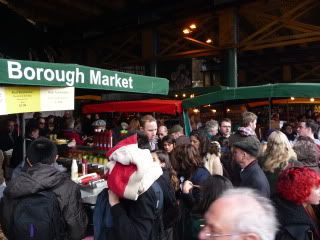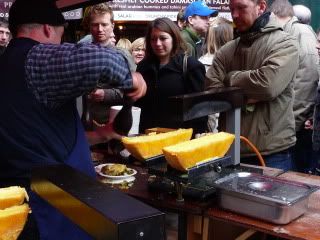London, part 3
Happy Anniversary! M+K. I won't say the exact number of years, but knowing that our Ds are living successfully on their own is a hint that the number is at least 2 digits!
On the way into the City this morning, K and S spent quite some time working on the nuances of our cameras (S and we have the same make/model). Last night at St Martin in the Fields the man sitting next to us also had the same camera! We now take acceptable photos on average with occasional flashes of brilliance, wheras before, our average was out of focus and not that great. K still managed to take the occasional brilliant shot, though.
We showed up at the Monument Tube Station for a 2-hour Foodies' Walk with London Walks. Except that the tube station was closed. Oops, so we got off at Bank and walked the streets til we found the right spot. Luckily we had left the hotel a little early so we had time to search for the meeting point, and also for a pit stop and coffee. Well, tea. No wait, it was actually hot chocolate!
The Foodies' Walk was great and I highly recommend it. It cost 7 GBP/person, started at the afforementioned Monument Tube Station and ended at the Boroughs Market two hours later. Note that each Foodies' Walk is different, so if you want to go on one, you best check the website to see where to meet and what you'll be seeing.
According to our guide, the famous London Fire of 1666 started in the oven of the King's Bakery and stopped in Pudding Lane, so the clergy claimed it was punishment for the city's sin of gluttony. Pudding Lane, of course, does not refer to dessert puddings or even blood pudding; it was the word for entrails, which were tossed into the street by the butchers up the hill and then washed down in the gutter into the Thames. After passersby got tangled up into a knot by the yards long intestines, the city passed a law requiring that the guts be chopped into 3 foot long pieces before being tossed.
Billingsgate used to be the city's fish market. Now all that's left is a fish on the roof. This fish is a stockfish, aka cod to Americans.

In the old days, about 1/3 of a Londoner's diet was fish, nowadays it's about 3 %. Eels, of course, are a famous London food, especially jellied eels which are apparently an acquired taste ("It's not the eels themselves, it's the liquor they come in that's so dreadful," said one of the other walkers on our tour).
As we crossed London Bridge (below, with St. Paul's cathedral in the background), we learned that the Thames has suffered as a fish habitat. In 1824, the last salmon was caught in the Thames, and just last week, the London paper reported that the eel population in the Thames has crashed, according to our guide. OTOH, the largest Dover sole spawning ground in the world is located at the mouth of the Thames.

Henry 8 and his wives really expanded Londoners' ideas about fruit: Catherine of Aragon, his first wife, brought sour Seville oranges from her native Spain; Anne Boleyn, his mistress/second wife, lusted after cherries so the royal gardener planted them by the orchard-full; and Henry himself liked a good stiff banana! (Now why does that sentence seem to capture the popular images of those historic figures?) In fact, a "Tudor banana" was found in the archaeology dig associated with a Thames bankside building. It was later determined that the banana was actually tossed into the pit by a worker some 3 weeks earlier.
In those days, vegetables were generally considered peasant food, and root crops were said to come from the devil since they grew underground. Garlic was punishment for the most horrid crimes. In the 1660s John Evelyn wrote a book about "the Herby diet" advocating for a vegetarian diet, but he really had a hard row to how getting people to accept it.
Then there's the pineapple. They were very expensive to grow, requiring a goodish-sized conservatory with knowing gardeners, resulting in a price of upwards of 5000GBP per fruit! In the 1800s, they were such a desirable fruit that you could rent one for an evening! To use as a decoration, I suppose. Heaven help you if a guest wanted to eat it!
At the south end of London Bridge is London Bridge station, a national railway station (railroad station in the American language). We stopped to watch the trains come and go, and learned that, in 1836, the railway came to London to change eating ideas yet again, bringing fresh fruit, veg and meat into the city. Fresh milk was especially prized, and Sainsbury's sold "Fresh Railway Milk." And of course, that's where the milk run or milk train came into being.
Alongside the walls of the elevated railway tracks lies Burough Market, an incredible street food market, a veritable foodie heaven, with about 100 stands selling all kinds of everything edible: cheese, meat, mushrooms, Spanish olive oil, dates, produce (including Brussels sprouts still on the stalk, which I had never seen except in photos), honey, everything you could think of. Amazing! We got samples of cheese and flaxcakes (thick chewy pancakes made with flax seeds (linseeds to Americans).

Oh, how I wish I lived near there! I'd go every week! but it's too far to commute, so we settled for getting melted cheese sandwiches from Kappacasein. I agree with the critics: this is a fantastic sandwich, the ideal of a toasted cheese sandwich for people who REALLY like cheese. Home-made peasant bread, grated Montgomery cheddar cheese, a relish of onions, leeks and I don't know what else but it was great! Then flattened between two hot iron sheets until the cheese was drippingly melted and the bread nicely golden, buttery brown. I don't have a photo of the sandwiches (ate them too quickly, I suppose) but here's the cheese toasting beneath a hot iron.

But K and S didn't agree.. *shakes head sadly* I guess we'll be eating different foods in heaven.
When we were finally sated on the food and the people (mostly the crowd, which was large and talkative and we saw several tourist groups following the raised umbrellas of their guides), we found our way back to the Tube station at London Bridge and went up to the City of London Museum.
This is under renovation (why should we have though we could see something without construction equipment around?) and the part from 1666 to the present is closed. But the first part of London's history, from prehistoric days to and including the Great Fire, was available to review.
I had a whole write-up here, but LJ deleted it. So you will just have to imagine the exhibits, or better still, go there to see them.
Yes, and imagine tea in the museum cafe where the counter helper gave me a tall red spikey flower.
And imagine dinner in the Indian restaurant by our hotel, and the Polish Karaoke at Polska Chatka.
Tant pis [too bad]. I mean, schade [too bad], but the French better expresses my thoughts at the moment.